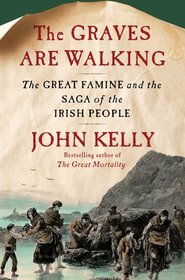We were taught about the Irish Potato Famine in elementary school. Irelands potato crop failed, many people died, many others moved to America to avoid starving. Next topic. If you have zero interest in the topic, that probably is all you need to know. However, if you would like a little detail, John Kellys The Graves Are Walking: The Great Famine and the Saga of the Irish People is required reading.
A crisis of the magnitude of the Irish Potato Famine has multiple facets. Kelly takes the time to explore each of them, starting with biological / scientific: What exactly caused the crops to die, and how did it spread so quickly across Ireland? And why was Ireland the only country affected? (A hint: it wasnt.) And how / why was it finally eradicated?
The majority of the book deals with the social, political, economic, and religious issues that surrounded and contributed to the crisis. After all, its one thing to say Someone should feed those people! but quite another to work out logistics such as Where is the replacement food coming from? How will it be distributed to those who need it? How will we determine who truly NEEDS it? and, always the big question: Who / how are we going to pay for it?
Ireland lost population in two major ways during the famine: death, and emigration. The book explores both the slow death caused by the famine, and the various methods used to leave the country (and in some cases, encourage them to leave) PLUS the problems faced and caused by the sudden influx of transplants by their host countries.
A confession: It took me a long time to read this book. By its very nature, it is not and cannot be the most uplifting text you are likely to encounter this year. Therefore, I broke it into three even (almost) segments, and took a break between each to read something lighter. However, I refused to give up; the content is important, and I am glad to have had the opportunity to read it.
Disclosure: I was given this book without charge by the publisher. A review was requested but not required.
A crisis of the magnitude of the Irish Potato Famine has multiple facets. Kelly takes the time to explore each of them, starting with biological / scientific: What exactly caused the crops to die, and how did it spread so quickly across Ireland? And why was Ireland the only country affected? (A hint: it wasnt.) And how / why was it finally eradicated?
The majority of the book deals with the social, political, economic, and religious issues that surrounded and contributed to the crisis. After all, its one thing to say Someone should feed those people! but quite another to work out logistics such as Where is the replacement food coming from? How will it be distributed to those who need it? How will we determine who truly NEEDS it? and, always the big question: Who / how are we going to pay for it?
Ireland lost population in two major ways during the famine: death, and emigration. The book explores both the slow death caused by the famine, and the various methods used to leave the country (and in some cases, encourage them to leave) PLUS the problems faced and caused by the sudden influx of transplants by their host countries.
A confession: It took me a long time to read this book. By its very nature, it is not and cannot be the most uplifting text you are likely to encounter this year. Therefore, I broke it into three even (almost) segments, and took a break between each to read something lighter. However, I refused to give up; the content is important, and I am glad to have had the opportunity to read it.
Disclosure: I was given this book without charge by the publisher. A review was requested but not required.




